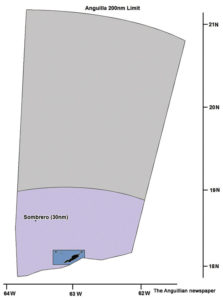
Anguillian fishermen are being encouraged to take advantage of the fishing grounds in the 200-nautical mile Exclusive Fishery Zone to the north of the island. At present nothing much is happening there except, perhaps, illegal fishing, preserving and canning of the various species of pelagic fish by Japanese and Taiwanese international fishermen.
The vast area of sea is believed to have such types of fish as tuna, mahi-mahi, wahoo and dolphin in abundance in its depths. Any fishing industry that Anguilla can establish from there – in the short, medium, or long term – would have much positive impact on the economic development of the island and, by extension, the tourism industry.
The Department of Fisheries and Marine Resources has drawn up a Fisheries Development Plan covering the period 2015-2025 which, to some extent, focuses on that area. The focus of the document is: “To guide the assessment of all Anguillian fisheries with a focus on the development of offshore deeper and/or pelagic fishing in the above zone to encourage economic growth; improve livelihoods and reduce the pressure on near-shore reef resources.”
The desire of the Department of Fisheries and Marine Resources is to see a number Anguillian fishermen becoming involved in fishing deep within the zone whether individually or in partnership with others.
“Not much is happening out there at the moment apart from probably some illegal fishing,” Mr. Stuart P. Wynne, Deputy Director of the Department, told The Anguillian in an interview. “We want to encourage local fishing operators to go out and explore the 200 nautical miles, and to take advantage of the fish resources. There are a few vessels that do so, and a new one is in the process of being licenced. It is owned by Sherwin Richardson who brought it over from the United States with the idea of doing long line fishing targeting tuna, mahi-mahi, wahoo, and other large pelagic species of fish. It is a bit of investment for fishermen who can make a lot of money through exports or sales in the local market including hotels. We are suggesting that fishermen club together and try to take advantage of the fishing resources out there.”
Mr. Wynne noted that local fishermen generally do not go beyond the Sombrero fishing grounds within the bottom of the zone. “What we are suggesting is that in order to bring in revenue for Government, foreign industrial fishing should be issued licences that would only permit them to fish beyond the 40-nautical mile area [exclusively reserved for Anguillian fishermen and as this is more accessible to them]. We would also like to encourage local fishermen to go out there as well [far into the 200 nautical miles], but we understand that in order to get to that distance you need large expensive boats.”
Mr. Wynne added: “We have reports that there is illegal fishing going on in the 200-nautical mile Economic Fishery Zone but we have no way of policing this. We are hoping that if we can encourage some local or St. Maarten operators, paying for licences, to legally go out there to fish, they can report back to us about illegal fishing in the zone; then, when the Royal Navy frigates go out there, they may be able to locate the illegal foreign fishermen. That is a massive challenge because we don’t have the required boat – and the Police boat is not big enough to go out there, but we have people who can report to us.”








